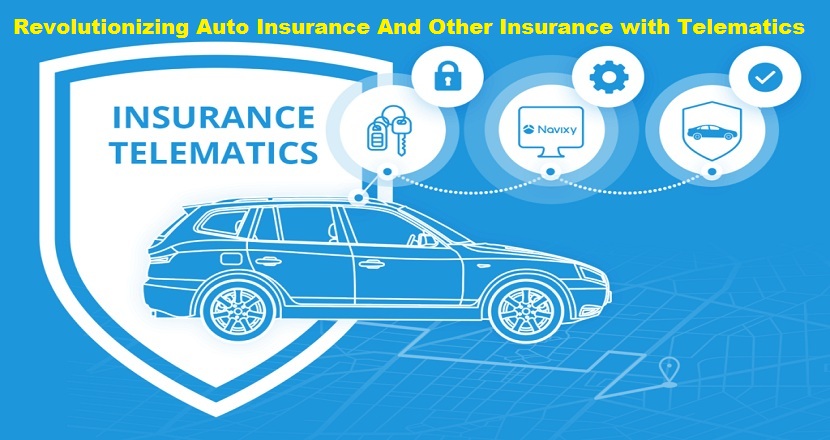Telematics in the Insurance Business:
In the evolving landscape of insurance, businesses are leveraging telematics to gain a comprehensive understanding of their clients. Telematics introduces a customer-centric strategy, offering insurance providers the opportunity to enhance customer service and expand their clientele. As a pivotal tool for businesses serving the auto insurance sector, telematics holds the potential to revolutionize the industry.
How Telematics Insurance Works
Shifting from Tradition: Usage-Based Auto Insurance
Traditionally, auto insurance rates were determined based on factors like a car’s make and model. Telematics disrupts this norm through Usage-Based Insurance (UBI). Telematics devices, installed in vehicles, track driving habits, including daily mileage, average speed, and safety levels. This data is then utilized to tailor insurance premiums, reflecting the specific risk associated with each vehicle. Telematics not only promotes affordability for safer drivers but also aids insurance companies in accurate risk assessment and mitigating fraudulent claims.
Implementing Telematics Technology: Varied Approaches
According to Allied Market Research, the telematics insurance market is projected to reach $13.78 billion by 2030, growing at a CAGR of 19.5%. Telematics implementation comes in various forms, including mobile apps, connect-in devices, GPS devices, onboard sensors, and mileage detection. These technologies provide insurance companies with diverse options for monitoring and analyzing driver behaviour, ensuring flexibility and effectiveness in risk management.
Applications of Telematics in Insurance Business
Diverse Applications of Telematics in the Insurance Industry
Telematics, initially synonymous with auto insurance, has evolved into a multi-faceted tool, transcending its traditional boundaries. The applications of telematics now extend far beyond auto insurance, offering a spectrum of benefits to both insurers and the insured.
1. Reporting Crash Data:
Telematics plays a pivotal role in reporting crash data, providing crucial information about the circumstances leading to accidents. This not only aids insurers in assessing claims more accurately but also helps law enforcement and other stakeholders in understanding the dynamics of road incidents.
2. Trailer Tracking:
In logistics and transport insurance, telematics facilitates trailer tracking. By attaching location units to trailers, insurers can monitor their movements and positions. This level of tracking enhances risk assessment, allowing insurers to adjust premiums based on the specific challenges associated with the transportation of goods.
3. GPS Anti-Theft Systems:
The integration of GPS technology in telematics has given rise to effective anti-theft systems. These systems track the location of insured vehicles in real time, acting as a deterrent to theft. In case of unauthorized movements, alerts are triggered, enabling swift response and potentially preventing theft-related insurance claims.
4. Fraud Prevention:
Telematics serves as a potent tool in the prevention of insurance fraud. By continuously monitoring driving behaviour, telematics can detect anomalies that may indicate fraudulent activities. This proactive approach not only safeguards insurers from fraudulent claims but also contributes to maintaining the integrity of the insurance ecosystem.
5. Better Risk Management for Businesses:
For commercial insurance, telematics aids in better risk management. By collecting and analyzing data related to fleet operations, driver behaviour, and vehicle conditions, insurers can offer tailored coverage and pricing. This promotes safer business practices, reduces the frequency of claims, and ultimately benefits both insurers and business clients.
6. Wireless Vehicle Safety Communications:
Telematics contributes to wireless vehicle safety communications, creating an interconnected network where vehicles share real-time safety data. This real-time exchange of information about road conditions, hazards, and vehicle speeds enhances overall road safety. Insurers can leverage this data for more accurate risk assessment and to encourage safe driving practices.
7. Cold Storage Freight Monitoring:
In the realm of cargo insurance, telematics plays a crucial role in cold storage freight monitoring. By collecting time-series data on temperature conditions inside cargo containers, insurers can ensure that goods requiring specific temperature ranges are transported under optimal conditions. This not only minimizes the risk of cargo damage but also contributes to overall supply chain efficiency.
8. Vehicle Emergency Warning Systems:
Telematics offers advanced features like vehicle emergency warning systems. In the event of emergencies, vehicles equipped with telematics can synchronize warnings with adjacent vehicles and infrastructure. This collaborative approach enhances overall emergency response, reduces the severity of accidents, and minimizes associated insurance risks.
In essence, the applications of telematics in the insurance sector showcase its adaptability and wide-ranging impact. From preventing fraud to enhancing road safety and optimizing risk management, telematics emerges as a transformative force, reshaping the landscape of insurance beyond traditional auto coverage. As insurers continue to explore innovative applications, telematics stands as a cornerstone for a more connected, informed, and secure insurance future.
Benefits of Using Telematics in the Insurance Business
Telematics systems, once confined to auto insurance, have emerged as transformative tools with far-reaching advantages in the insurance business. The key benefits of integrating telematics extend across customer engagement, competitive positioning, cost reduction, and the cultivation of a tech-friendly image.
1. Customer Engagement:
Telematics systems play a pivotal role in enhancing customer engagement by enabling efficient categorization of customers and the provision of personalized insurance plans. The technology facilitates ongoing interaction through dedicated apps and devices, fostering a sense of customer satisfaction and loyalty. Insurers leveraging telematics can tailor their offerings based on real-time data, ensuring that insurance plans align with individual needs and preferences.
2. Competitive Edge:
Keeping insurers ahead of the competition is one of the hallmarks of telematics. The technology empowers insurers to create innovative pricing structures and identify safe drivers accurately. By utilizing the wealth of data generated by telematics devices, insurance companies can differentiate themselves by offering rewards and incentives for safe driving behaviour. This not only attracts safer drivers but also positions insurers as industry leaders in promoting responsible driving habits.
3. Cost Reduction:
Telematics translates into tangible cost reductions for organizations. The potential for lower claims is a direct outcome of improved driver behaviour incentivized by telematics. Safer driving practices encouraged through reward programs, lead to fewer accidents and reduced insurance claims. Additionally, telematics contributes to streamlined processes, allowing insurers to efficiently manage claims and make informed decisions based on real-time data.
4. Tech-Friendly Image:
The adoption of telematics goes beyond financial benefits; it projects an image of innovation and tech-friendliness for insurance organizations. Offering mobile telematics options signifies a commitment to meet evolving customer needs and embracing technological advancements. This proactive approach not only aligns with the expectations of tech-savvy customers but also creates a positive perception of the insurance provider. The availability of modern, technology-driven solutions enhances the overall brand image and competitiveness of the insurer.
5. Personalized Relationships:
Telematics fosters a closer and more personalized relationship between insurers and their clients. The ability to offer customized insurance plans based on real-time data builds trust and rapport. Even for customers who may not currently opt for telematics, the perception of the insurer as a tech-friendly entity contributes to a positive customer experience. The continuous engagement facilitated by telematics, whether through apps or other devices, creates a dynamic and responsive relationship between insurers and policyholders.
In summary, telematics is a driving force in revolutionizing the insurance landscape. From boosting customer engagement to securing a competitive edge, reducing costs, and projecting a tech-friendly image, the benefits of telematics extend across multiple dimensions. As insurers embrace this transformative technology, they not only optimize their operational efficiency but also pave the way for a more dynamic and customer-centric future in the insurance industry.
Impact of Telematics on Other Insurance Sectors
Extending Telematics Beyond Auto Insurance
While currently prominent in auto insurance, telematics is poised to impact other insurance sectors. In health insurance, it can offer activity-based reward programs, and in life insurance, it can personalize premium quotes based on individual behaviour. Telematics also holds promise in home insurance, simplifying underwriting processes and enhancing risk assessment through real-time monitoring of property conditions.
Challenges Associated with Telematics
Telematics Challenges: Balancing Transformation with Privacy and Collaboration
While telematics stands as a transformative force in the insurance industry, it encounters challenges that necessitate careful navigation. The primary hurdles revolve around privacy concerns and the complexities associated with data collaboration.
1. Privacy Concerns:
The transformative potential of telematics is closely intertwined with real-time data collection on driving habits. However, this very aspect raises legitimate privacy concerns among users. Customers may feel apprehensive about the constant monitoring of their driving behaviour and the potential implications for their privacy. Striking a delicate balance between the benefits of telematics and respecting individual privacy becomes a crucial aspect of ensuring widespread acceptance and adoption.
2. Collaboration Complexities:
Telematics relies heavily on data, and when insurers seek to collaborate or participate in partnerships, collaboration complexities may arise. The challenge lies in effectively sharing data without compromising individual privacy or proprietary information. Insurers need to navigate through intricate collaborations, ensuring that data is shared seamlessly, securely, and ethically. An effective insurance platform becomes a strategic necessity to organize data streams, uphold privacy standards, and foster collaboration within the dynamic and evolving telematics landscape.
3. The Role of Insurance Platforms:
Amidst these challenges, the role of an effective insurance platform becomes paramount. Such a platform serves as the linchpin for managing data streams generated by telematics devices. It provides a structured framework for insurers to organize, analyze, and utilize the wealth of data at their disposal. Additionally, the platform acts as a facilitator for seamless collaboration, offering tools and protocols that uphold privacy standards and ethical data-sharing practices.
4. Data Organization and Facilitation:
Insurance platforms are instrumental in organizing telematics data, ensuring that it is efficiently categorized and utilized for various purposes, from risk assessment to premium calculations. These platforms incorporate advanced analytics tools that extract meaningful insights while safeguarding sensitive information. The ability to streamline and organize data contributes to a more agile and responsive insurance ecosystem.
5. Privacy Safeguards:
To address privacy concerns, insurance platforms incorporate robust privacy safeguards. These safeguards may include anonymization techniques, encryption protocols, and adherence to stringent data protection regulations. By implementing these measures, insurers demonstrate a commitment to safeguarding customer privacy while harnessing the benefits of telematics for operational efficiency and risk management.
In the last, the challenges associated with telematics, particularly privacy concerns and collaboration complexities, underscore the importance of a sophisticated insurance platform. As insurers navigate the transformative landscape of telematics, the strategic deployment of such platforms becomes integral to ensuring the ethical use of data, maintaining customer trust, and fostering successful collaborations within the evolving telematics ecosystem.
Conclusion
In conclusion, the integration of telematics marks a paradigm shift in the insurance industry. From redefining auto insurance pricing to fostering customer engagement and innovation, telematics emerges as a transformative force. As insurers navigate the challenges and explore diverse applications, embracing telematics positions them at the forefront of an evolving, tech-driven insurance landscape. The future promises not only improved operational efficiency and risk management but also a closer, more personalized relationship between insurers and their clients.





Leave a Reply